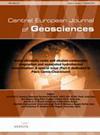巴西上Paranaíba火成岩省地幔捕虏体中的镁辉石和钾辉石:成因及其对地幔交代作用的制约
引用次数: 16
摘要
在巴西东南部Alto Paranaíba火成岩省Limeira 1碱性侵入岩的金伯利岩类岩石包裹的地幔包体中发现了含碱Ti氧化物。交代矿物组合主要为辉黄铁矿和辉黄铁矿,伴生有斜辉石、绿云母、钛铁矿和金红石。镁辉石(55-60 wt.%);5.2-6.7 wt.% ZrO2)出现在橄榄岩捕虏体中,在双反应边缘日冕中,包围铬铁矿(~ 50 wt.% Cr2O3)和次级钛铁矿(12-13.4 wt.% MgO)。铁铅矿(Ba/(K+Ba)< 0.05)以片状形式存在于镁钛铁矿(MgO含量为8.4-9.8 wt.%)的捕虏体中,或以金红石晶体的互生形式存在于钾绿云母中。镁辉石是橄榄岩原生矿物与碱性熔体反应形成的。橄榄岩矿物与超经典熔体反应形成钾辉石。伴生矿物的不平衡结构和化学分带表明,导致含碱钛氧化物形成的交代反应发生在宿主岩浆夹带捕虏体之前不久,与古老的(元古代)地幔富集事件无关。本文章由计算机程序翻译,如有差异,请以英文原文为准。
Mathiasite-loveringite and priderite in mantle xenoliths from the Alto Paranaíba Igneous Province, Brazil: genesis and constraints on mantle metasomatism
Alkali-bearing Ti oxides were identified in mantle xenoliths enclosed in kimberlite-like rocks from Limeira 1 alkaline intrusion from the Alto Paranaíba Igneous Province, southeastern Brazil. The metasomatic mineral assemblages include mathiasite-loveringite and priderite associated with clinopyroxene, phlogopite, ilmenite and rutile. Mathiasite-loveringite (55–60 wt.% TiO2; 5.2–6.7 wt.% ZrO2) occurs in peridotite xenoliths rimming chromite (∼50 wt.% Cr2O3) and subordinate ilmenite (12–13.4 wt.% MgO) in double reaction rim coronas. Priderite (Ba/(K+Ba)< 0.05) occurs in phlogopite-rich xenoliths as lamellae within Mg-ilmenite (8.4–9.8 wt.% MgO) or as intergrowths in rutile crystals that may be included in sagenitic phlogopite. Mathiasite-loveringite was formed by reaction of peridotite primary minerals with alkaline melts. The priderite was formed by reaction of peridotite minerals with ultrapotassic melts. Disequilibrium textures and chemical zoning of associated minerals suggest that the metasomatic reactions responsible for the formation of the alkali-bearing Ti oxides took place shortly prior the entrainment of the xenoliths in the host magma, and is not connected to old (Proterozoic) mantle enrichment events.
求助全文
通过发布文献求助,成功后即可免费获取论文全文。
去求助
来源期刊

Central European Journal of Geosciences
GEOSCIENCES, MULTIDISCIPLINARY-
自引率
0.00%
发文量
0
审稿时长
>12 weeks
 求助内容:
求助内容: 应助结果提醒方式:
应助结果提醒方式:


